

Introducing Mule Enterprise Security. Service-Oriented Architectures (SOA) present unique security challenges due to loose service/application coupling and operations running across trust boundaries.
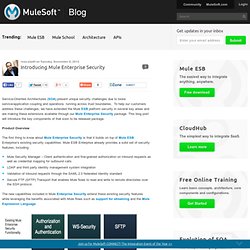
To help our customers address these challenges, we have extended the Mule ESB platform security in several key areas and are making these extensions available through our Mule Enterprise Security package. This blog post will introduce the key components of that soon to be released package. Product Overview. OAuth 2 just got a bit easier. Ever since Devkit made its first entry into the Mule family, a big variety of OAuth enabled Cloud Connectors were made available.
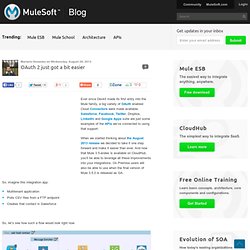
Salesforce, Facebook, Twitter, Dropbox, LinkedIn and Google Apps suite are just some examples of the APIs we’ve connected to using that support. When we started thinking about the August 2013 release we decided to take it one step forward and make it easier than ever. And now that Mule 3.5-andes is available on CloudHub, you’ll be able to leverage all these improvements into your integrations. On Premise users will also be able to use when the final version of Mule 3.5.0 is released as GA. So, imagine this integration app: Multitenant applicationPolls CSV files from a FTP endpointCreates that contact in Salesforce So, let’s see how such a flow would look right now: So that doesn’t look that bad!
Ever since Mule 3.3.1, Cloud Connectors have provided support for multi tenant applications. Mule Gmail Cloud Connector. October 2013 Release: Expanded DataSense connectivity. Expanded DataSense capabilities We believe that metadata-driven design is the number one productivity enhancer for SaaS to on-premise integration.
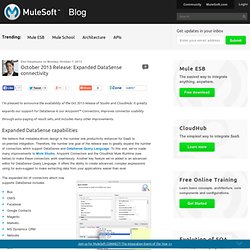
Therefore, the number one goal of the release was to greatly expand the number of connectors which support DataSense and DataSense Query Language. To this end, we’ve made many improvements to Mule Studio, Anypoint Connectors and the CloudHub Mule Runtime (see below) to make these connectors work seamlessly. Another key feature we’ve added is an advanced editor for DataSense Query Language. It offers the ability to create advanced, complex expressions using for auto-suggest to make extracting data from your applications easier than ever. The expanded list of connectors which now supports DataSense includes: Additionally, we’re updating more and more connectors all the time, with many more coming before the end of the year.
How to Protect Your APIs with OAuth. On this 10th ‘Day of Christmas’ Mule blog post, we tackle an increasingly important question in the world of APIs: Presume that you would like to create a remote API (which perhaps exposes some legacy business logic) for access by internal and/or external clients.
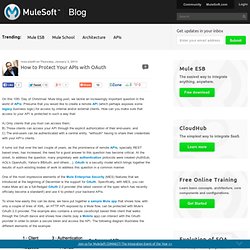
How can you make sure that access to your API is protected in such a way that: A) Only clients that you trust can access them; B) Those clients can access your API through the explicit authorization of their end-users; and C) The end-users can be authenticated with a central entity, *withouth* having to share their credentials with your API’s clients. It turns out that over the last couple of years, as the prominence of remote APIs, specially REST based ones, has increased, the need for a good answer to this question has become critical.
At the onset, to address the question, many proprietary web authentication protocols were created (AuthSub, AOL’s OpenAuth, Yahoo’s BBAuth, and others…). 2.0 — OAuth. OAuth 2.0 is the industry-standard protocol for authorization.
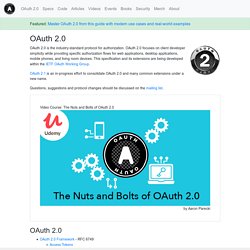
OAuth 2.0 supersedes the work done on the original OAuth protocol created in 2006. OAuth 2.0 focuses on client developer simplicity while providing specific authorization flows for web applications, desktop applications, mobile phones, and living room devices. This specification and its extensions are being developed within the IETF OAuth Working Group. Questions, suggestions and protocol changes should be discussed on the mailing list. OAuth 2.0 Core 🍎 What the Heck is Sign In with Apple? Sign In with Apple is based on OAuth 2.0 and OpenID Connect, and provides a privacy-friendly way for users to sign in to websites and apps. Mobile and Other Devices Native Apps - Recommendations for using OAuth 2.0 with native apps PKCE - Proof Key for Code Exchange, better security for native apps Browser-Based Apps - Recommendations for using OAuth 2.0 with browser-based apps (e.g. an SPA) OAuth 2.0 Device Flow Token and Token Management.
Authentication & Resource Sharing over the Web: OAuth protocol. If you reached this blog and you are not a Mule user (yet) keep reading, I will not cover anything Mule specific.
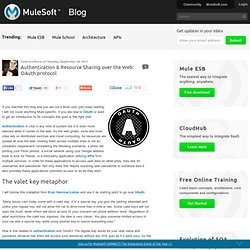
If you are new to OAuth or want to get an introduction to its concepts this post is the right one! Authentication is vital in any kind of system but it is even more relevant when it comes to the web. As the web grows, more and more sites rely on distributed services and cloud computing. As resources are spread all over the web, sharing them across multiple sites is not an unrealistic requirement considering the following scenarios: a photo lab printing your Flickr photos, a social network using your Google address book to look for friends, or a third-party application utilizing APIs from multiple services. Mule OAuth2 support: Even easier still. This post is brought to you by… you!
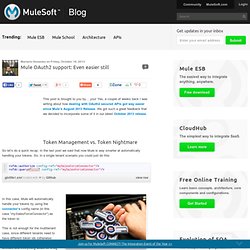
Yes, a couple of weeks back I was writing about how dealing with OAuth2 secured APIs got way easier since Mule’s August 2013 Release. We got such a great feedback that we decided to incorporate some of it in our latest October 2013 release. Token Management vs. Token Nightmare So let’s do a quick recap. In this case, Mule will automatically handle your tokens by using the connector’s config name (in this case “mySalesForceConnector“) as the token id.
OAuth. For MediaWiki's (the software used by Wikipedia) OAuth support, see mw:Help:OAuth OAuth is an open standard for authorization, commonly used as a way for Internet users to log into third party websites using their Microsoft, Google, Facebook or Twitter accounts without exposing their password.[1] Generally, OAuth provides to clients a 'secure delegated access' to server resources on behalf of a resource owner.

It specifies a process for resource owners to authorize third-party access to their server resources without sharing their credentials. Designed specifically to work with Hypertext Transfer Protocol (HTTP), OAuth essentially allows access tokens to be issued to third-party clients by an authorization server, with the approval of the resource owner. The third party then uses the access token to access the protected resources hosted by the resource server.[2] Connector Callback Testing – Local. Testing using an external API can be a PITA, especially if the API uses any HTTP Callbacks or redirects such as OAuth or WebHooks.

If your using any callback functionality like this then the Service Provider needs a way to callback your application and therefore be accessible to the public Internet. When you start integrating these APIs, it’s much easier to work on your local development machine, but these are usually behind firewalls, NAT, or are otherwise not able to provide a public URL and it’s not really feasible to push to a staging environment every time you want to test something. So we need a way to make our local applications available to the Internet; there are a few good services and tools out there to help with this such as: Tunnlr, ProxyLocal, showoff.io or you can setup your own reverse SSH Tunnel if you already have a remote system to forward you requests.
Installing Localtunnel Ruby, Ruby, Ruby! LocalTunnel can be installed by using RubyGems. Creating public and private keys. Authentication Methods Overview - Current Mule Documentation. There are several common authentication protocols that APIs generally use.
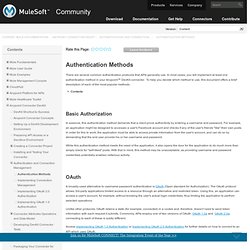
In most cases, you will implement at least one authentication method in your Anypoint™ DevKit connector. To help you decide which method to use, this document offers a brief description of each of the most popular methods. Basic Authorization In essence, this authentication method demands that a client prove authenticity by entering a username and password.